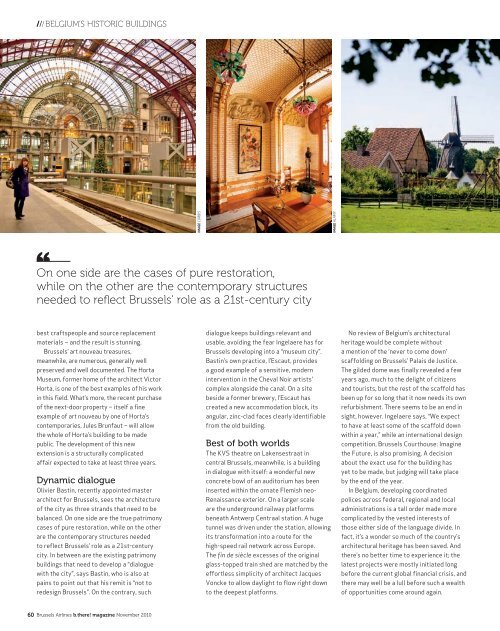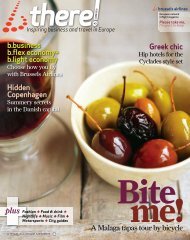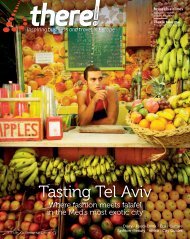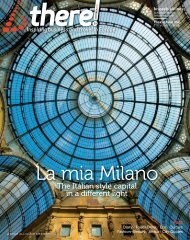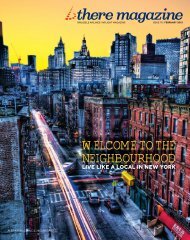november-2010
november-2010
november-2010
Create successful ePaper yourself
Turn your PDF publications into a flip-book with our unique Google optimized e-Paper software.
BELGIUM’S HISTORIC BUILDINGS<br />
On one side are the cases of pure restoration,<br />
while on the other are the contemporary structures<br />
needed to refl ect Brussels’ role as a 21st-century city<br />
best craftspeople and source replacement<br />
materials – and the result is stunning.<br />
Brussels’ art nouveau treasures,<br />
meanwhile, are numerous, generally well<br />
preserved and well documented. The Horta<br />
Museum, former home of the architect Victor<br />
Horta, is one of the best examples of his work<br />
in this field. What’s more, the recent purchase<br />
of the next-door property – itself a fine<br />
example of art nouveau by one of Horta’s<br />
contemporaries, Jules Brunfaut – will allow<br />
the whole of Horta’s building to be made<br />
public. The development of this new<br />
extension is a structurally complicated<br />
affair expected to take at least three years.<br />
Dynamic dialogue<br />
Olivier Bastin, recently appointed master<br />
architect for Brussels, sees the architecture<br />
of the city as three strands that need to be<br />
balanced. On one side are the true patrimony<br />
cases of pure restoration, while on the other<br />
are the contemporary structures needed<br />
to reflect Brussels’ role as a 21st-century<br />
city. In between are the existing patrimony<br />
buildings that need to develop a “dialogue<br />
with the city”, says Bastin, who is also at<br />
pains to point out that his remit is “not to<br />
redesign Brussels”. On the contrary, such<br />
60 Brussels Airlines b.there! magazine November <strong>2010</strong><br />
IMAGE CORBIS<br />
dialogue keeps buildings relevant and<br />
usable, avoiding the fear Ingelaere has for<br />
Brussels developing into a “museum city”.<br />
Bastin’s own practice, l’Escaut, provides<br />
a good example of a sensitive, modern<br />
intervention in the Cheval Noir artists’<br />
complex alongside the canal. On a site<br />
beside a former brewery, l’Escaut has<br />
created a new accommodation block, its<br />
angular, zinc-clad faces clearly identifiable<br />
from the old building.<br />
Best of both worlds<br />
The KVS theatre on Lakensestraat in<br />
central Brussels, meanwhile, is a building<br />
in dialogue with itself: a wonderful new<br />
concrete bowl of an auditorium has been<br />
inserted within the ornate Flemish neo-<br />
Renaissance exterior. On a larger scale<br />
are the underground railway platforms<br />
beneath Antwerp Centraal station. A huge<br />
tunnel was driven under the station, allowing<br />
its transformation into a route for the<br />
high-speed rail network across Europe.<br />
The fin de siècle excesses of the original<br />
glass-topped train shed are matched by the<br />
effortless simplicity of architect Jacques<br />
Voncke to allow daylight to flow right down<br />
to the deepest platforms.<br />
IMAGE ALAMY<br />
No review of Belgium’s architectural<br />
heritage would be complete without<br />
a mention of the ‘never to come down’<br />
scaffolding on Brussels’ Palais de Justice.<br />
The gilded dome was finally revealed a few<br />
years ago, much to the delight of citizens<br />
and tourists, but the rest of the scaffold has<br />
been up for so long that it now needs its own<br />
refurbishment. There seems to be an end in<br />
sight, however. Ingelaere says, “We expect<br />
to have at least some of the scaffold down<br />
within a year,” while an international design<br />
competition, Brussels Courthouse: Imagine<br />
the Future, is also promising. A decision<br />
about the exact use for the building has<br />
yet to be made, but judging will take place<br />
by the end of the year.<br />
In Belgium, developing coordinated<br />
polices across federal, regional and local<br />
administrations is a tall order made more<br />
complicated by the vested interests of<br />
those either side of the language divide. In<br />
fact, it’s a wonder so much of the country’s<br />
architectural heritage has been saved. And<br />
there’s no better time to experience it; the<br />
latest projects were mostly initiated long<br />
before the current global financial crisis, and<br />
there may well be a lull before such a wealth<br />
of opportunities come around again.


